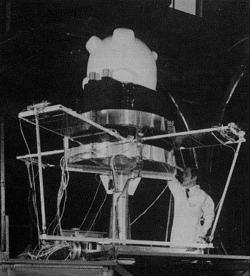Programme history
Managerial
At a meeting of the Committee on Space Research, the United States offered to provide assistance to other countries with the development and launch of scientific spacecraft. In late 1959, the British National Committee for Space Research (BNCSR) proposed the development of Ariel 1 to NASA. By early the following year the two countries had decided upon terms for the Ariel programme's scope and which organisations would be responsible for which parts of the programme.
In 1961 the UK Space Research Group accepted proposals for experiments to be carried on the third satellite of the Ariel programme. The BNCSR selected experiments from those proposals and submitted them to NASA in 1962. The scientific objectives for the mission were selected in January 1963, and full work on the satellite began in early 1964 due to organisational and financial difficulties.
Plans for Ariel 5 were first discussed between the UK and US in May 1967 at the Ariel 3 launch. The Science Research Council (SRC) advertised a request for proposal for experiments in June. Experiments were formally proposed to NASA in July 1968.
Operational
The first three satellites in the series were spin stabilized but had no attitude control system, which affected experiments which required pointing. Ariel 4 had some degree of attitude control by using magnetorquers. Since Ariel 5 was primarily an X-ray detecting satellite, more precise attitude control was needed. The spin rate could be actively changed using a propane cold gas thrusters, while spin angle was controlled with magnetorquers.
Experimental
The first four satellites primarily studied the ionosphere. It was realized that higher quality X-ray data could be collected in space, and the experiments of Ariel 5 were designed to meet that primary objective. The last satellite in the series had a cosmic ray experiment and two X-ray experiments which would expand the data collected by its predecessor.
Launch
All launches were conducted using American rockets. The Scout rocket was being developed as an inexpensive launcher for payloads up to 50 kilograms (110 lb) to low Earth orbit (LEO) and Ariel 1 was intended to launch on it. The Scout rocket was not ready in time, so Ariel 1 launched on the more expensive Thor-Delta, with the Americans footing the bill. [15] The remaining Ariel satellites launched on Scouts.
The first two launches were on the East coast. The Ariel 3 launch was originally planned for Wallops, but in 1964 experimenters requested an inclination change to the proposed orbit to maximize scientific value. This change precipitated the launch site moving to the West coast. Three of the experiments on Ariel 4 were the same as its predecessor, so it too launched from Vandenberg AFB. Like the first Ariel programme satellites, Ariel 5 was planned to launch from Wallops Island. The satellite would perform better operationally and scientifically at a near-equatorial orbit, close to a 0° inclination. To achieve this it was launched from the Italian San Marco off the coast of Kenya. The last satellite in the series did not require a special orbit, so Wallops Island was used as the launch facility. This was the first launch that the SRC paid for; previous launches were funded by NASA.
This page is based on this
Wikipedia article Text is available under the
CC BY-SA 4.0 license; additional terms may apply.
Images, videos and audio are available under their respective licenses.





